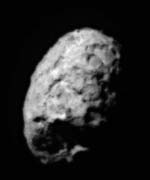
Image credit: NASA/JPL
Now that it’s survived its dangerous journey through the tail of Comet Wild-2, NASA’s Stardust spacecraft is heading for home. On board is its precious cargo of comet fragments that will be returned to Earth in 2006 for analysis by scientists. Even though the spacecraft’s camera was only really designed for navigation, it took 72 photographs which are some of the best images of a comet ever taken. Scientists hope that the cometary particles will help answer questions about the earliest history of our solar system.
Having weathered its out-of-this-world sandblasting by cometary particles hurtling toward it at about six times the speed of a rifle bullet, NASA’s Stardust spacecraft begins its two-year, 1.14 billion kilometer (708 million mile) trek back to its planet of origin.
“On January 2, comet Wild 2 gave up its particles but it did not do so without a fight,” said Stardust Project Manager Tom Duxbury of NASA’s Jet Propulsion Laboratory, Pasadena, Calif. “Our data indicates we flew through sheets of cometary particles that jostled the spacecraft and that on at least 10 occasions the first layer of our shielding was breeched. Glad we had a couple more layers of the stuff.”
Stardust entered the comet’s coma ? the vast cloud of dust and gas that surrounds a comet’s nucleus – on December 31, 2003. From that point on it kept its defensive shielding between it and what scientists hoped would be the caustic stream of particles it would fly through. And fly through cometary particles Stardust did, but not in the fashion the team envisioned while designing the mission.
“We thought we would see a uniform increase in the number of particles the closer we came to the comet’s nucleus and then a reduction,” said University of Washington scientist Dr. Don Brownlee, Stardust’s Principal Investigator. “Instead, our data indicate we flew through a veritable swarm of particles and then there would be almost nothing and then we would fly through another swarm.”
Stardust scooped up these cometary particles, impacting at 6.1 kilometers per second (3.8 miles per second), for almost instantaneous analysis from onboard instruments and stored other particles for later, in-depth analysis, here on Earth. Along with this cosmic taste testing, the spacecraft also took some remarkable images of comet Wild 2’s five-kilometer wide (3.1- mile wide) nucleus.
“Our navigation camera was designed to assist in navigation, not science,” said Stardust’s imaging team lead Ray Newburn. “But these are the best images ever taken of a comet and there is a remarkable amount of information in those 72 pictures. Not only did we image the jets of material spewing out from the comet, but for the first time in history we can actually see the location of their origin on the surface of the comet.”
At about 11:25 am Pacific Standard Time (2:25pm EST) on Jan. 2, only minutes after its closest approach with the comet, Stardust pointed its high gain antenna at Earth and began transmitting a data stream that took over 30 hours to send but will keep cometary scientists busy for years to come. About six hours later another event took place that goes a long way to literally increasing the scientists task load exponentially.
“Six hours after encounter we retracted the collector grid, with what we are all confident is an abundance of cometary particles, into the spacecraft’s sample return capsule,” added Duxbury. “The next time the sample return capsule is going to be opened is in a clean room at the Johnson Space Center in the days following Earth return in January 2006.”
Scientists expect in-depth terrestrial analysis of the samples will reveal much about comets and the earliest history of the solar system. Chemical and physical information locked within the particles could be the record of the formation of the planets and the materials from which they were made. More information on the Stardust mission is available at http://stardust.jpl.nasa.gov.
Stardust, a part of NASA’s Discovery Program of low-cost, highly focused science missions, was built by Lockheed Martin Space Systems, Denver, Colo., and is managed by JPL for NASA’s Office of Space Science, Washington, D.C. JPL is a division of the California Institute of Technology in Pasadena.
Original Source: NASA/JPL News Release
